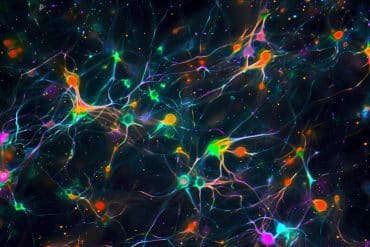Summary: Researchers discovered an important component of myelination following birth that could help treat neurodegenerative diseases.
Source: University at Buffalo.
The discovery that a certain type of calcium channel is critical may lead to improved therapies for diseases like multiple sclerosis.
Researchers at the University at Buffalo have identified a critical step in myelination after birth that has significance for treating neurodegenerative diseases like multiple sclerosis, in which myelin is lost or damaged. Myelin is the protective coating that neurons need to function.
The preclinical research, published online in October in the Journal of Neuroscience, concerns oligodendrocytes, the cells that make myelin, and the progenitor cells that are their precursors.
The work involved the study of voltage-operated calcium channels, which are responsible for initiating many physiological functions.
How myelin-making cells mature
“Our findings show that these calcium channels modulate the maturation of oligodendrocytes in the brain after birth,” said Pablo M. Paez, PhD, an assistant professor in the Department of Pharmacology and Toxicology in the Jacobs School of Medicine and Biomedical Sciences at UB and a research scientist with the Hunter James Kelly Research Institute (HJKRI) at UB, where most of the work was done.
“That’s important because it’s possible that the activity of this calcium channel can be manipulated pharmacologically to encourage oligodendrocyte maturation and remyelination after demyelinating episodes in the brain,” he said.
Within two weeks after birth, the researchers found, the maturation of oligodendrocytes and myelination will proceed so long as calcium channels are functioning properly. In their experiments, mice from whom these calcium channels were removed had abnormal oligodendrocyte maturation, which prevented normal myelination.
Based on these findings, Paez said it appears that in these animals, the inability to develop myelin normally persists into adulthood, suggesting that the expression of voltage-operated calcium channels during the first steps of myelination is essential for the brain’s normal development.
“If we can further enhance our understanding of how these oligodendrocyte precursor cells mature, then it may be possible to stimulate them to replace myelin in diseases like multiple sclerosis,” he said.
“Demyelination — the loss of myelin — impairs the ability of nerve impulses to travel from nerve cell to nerve cell,” Paez explained. “That can lead to deficits in motor, sensory and/or cognitive function. While remyelination occurs in many multiple sclerosis lesions, this becomes increasingly less effective over time and eventually fails.”

The results are of particular interest, he noted, because many therapies are already on the market that target calcium channels for cardiovascular disorders and other diseases.
“The pharmacology of these calcium channel blockers is very well-understood, so an understanding of how they influence myelination could potentially bring us closer to new therapies more rapidly than some other therapeutic possibilities,” said Lawrence Wrabetz, MD, professor of neurology and biochemistry and director of the HJKRI.
Scientists at the HJKRI conduct research to better understand myelin, the fatty insulator that enables communication between nerve cells. The researchers study how damage to myelin occurs, and how that damage may be repaired. The institute, part of UB’s New York State Center of Excellence in Bioinformatics and Life Sciences, was established in 1997 by Buffalo Bills Hall of Fame quarterback Jim Kelly and his wife Jill after their infant son Hunter, was diagnosed with Krabbe Leukodystrophy, an inherited fatal disorder. He died in 2005 at the age of 8.
In addition to Paez, co-authors from the Hunter James Kelly Research Institute are Veronica T. Cheli, Diara A. Santiago Gonzalez, Tenzing N. Lama and Vilma Spreuer. Other co-authors are Vance Handley from the David Geffen School of Medicine, UCLA and Geoffrey G. Murphy in the Department of Physiology, University of Michigan.
Funding: The research was supported by the National Institute of Neurological Disorders and Stroke and the National Multiple Sclerosis Society.
Source: Ellen Goldbaum – University at Buffalo
Image Source: NeuroscienceNews.com image is credited to Pablo Paez.
Original Research: Abstract for “Conditional Deletion of the L-Type Calcium Channel Cav1.2 in Oligodendrocyte Progenitor Cells Affects Postnatal Myelination in Mice” by Veronica T. Cheli, Diara A. Santiago González, Tenzing Namgyal Lama, Vilma Spreuer, Vance Handley, Geoffrey G. Murphy and Pablo M. Paez in Journal of Neuroscience. Published online October 19 2016 doi:10.1523/JNEUROSCI.1770-16.2016
[cbtabs][cbtab title=”MLA”]University at Buffalo. “New Clues to Myelination Could Help Identify Ways to Intervene in Neurodegenerative Diseases.” NeuroscienceNews. NeuroscienceNews, 8 December 2016.
<https://neurosciencenews.com/neurodegeneration-myelination-5710/>.[/cbtab][cbtab title=”APA”]University at Buffalo. (2016, December 8). New Clues to Myelination Could Help Identify Ways to Intervene in Neurodegenerative Diseases. NeuroscienceNews. Retrieved December 8, 2016 from https://neurosciencenews.com/neurodegeneration-myelination-5710/[/cbtab][cbtab title=”Chicago”]University at Buffalo. “New Clues to Myelination Could Help Identify Ways to Intervene in Neurodegenerative Diseases.” https://neurosciencenews.com/neurodegeneration-myelination-5710/ (accessed December 8, 2016).[/cbtab][/cbtabs]
Abstract
Conditional Deletion of the L-Type Calcium Channel Cav1.2 in Oligodendrocyte Progenitor Cells Affects Postnatal Myelination in Mice
To determine whether L-type voltage-operated Ca2+ channels (L-VOCCs) are required for oligodendrocyte progenitor cell (OPC) development, we generated an inducible conditional knock-out mouse in which the L-VOCC isoform Cav1.2 was postnatally deleted in NG2-positive OPCs. A significant hypomyelination was found in the brains of the Cav1.2 conditional knock-out (Cav1.2KO) mice specifically when the Cav1.2 deletion was induced in OPCs during the first 2 postnatal weeks. A decrease in myelin proteins expression was visible in several brain structures, including the corpus callosum, cortex, and striatum, and the corpus callosum of Cav1.2KO animals showed an important decrease in the percentage of myelinated axons and a substantial increase in the mean g-ratio of myelinated axons. The reduced myelination was accompanied by an important decline in the number of myelinating oligodendrocytes and in the rate of OPC proliferation. Furthermore, using a triple transgenic mouse in which all of the Cav1.2KO OPCs were tracked by a Cre reporter, we found that Cav1.2KO OPCs produce less mature oligodendrocytes than control cells. Finally, live-cell imaging in early postnatal brain slices revealed that the migration and proliferation of subventricular zone OPCs is decreased in the Cav1.2KO mice. These results indicate that the L-VOCC isoform Cav1.2 modulates oligodendrocyte development and suggest that Ca2+ influx mediated by L-VOCCs in OPCs is necessary for normal myelination.
SIGNIFICANCE STATEMENT Overall, it is clear that cells in the oligodendrocyte lineage exhibit remarkable plasticity with regard to the expression of Ca2+ channels and that perturbation of Ca2+ homeostasis likely plays an important role in the pathogenesis underlying demyelinating diseases. To determine whether voltage-gated Ca2+ entry is involved in oligodendrocyte maturation and myelination, we used a conditional knock-out mouse for voltage-operated Ca2+ channels in oligodendrocyte progenitor cells. Our results indicate that voltage-operated Ca2+ channels can modulate oligodendrocyte development in the postnatal brain and suggest that voltage-gated Ca2+ influx in oligodendroglial cells is critical for normal myelination. These findings could lead to novel approaches to intervene in neurodegenerative diseases in which myelin is lost or damaged.
“Conditional Deletion of the L-Type Calcium Channel Cav1.2 in Oligodendrocyte Progenitor Cells Affects Postnatal Myelination in Mice” by Veronica T. Cheli, Diara A. Santiago González, Tenzing Namgyal Lama, Vilma Spreuer, Vance Handley, Geoffrey G. Murphy and Pablo M. Paez in Journal of Neuroscience. Published online October 19 2016 doi:10.1523/JNEUROSCI.1770-16.2016






